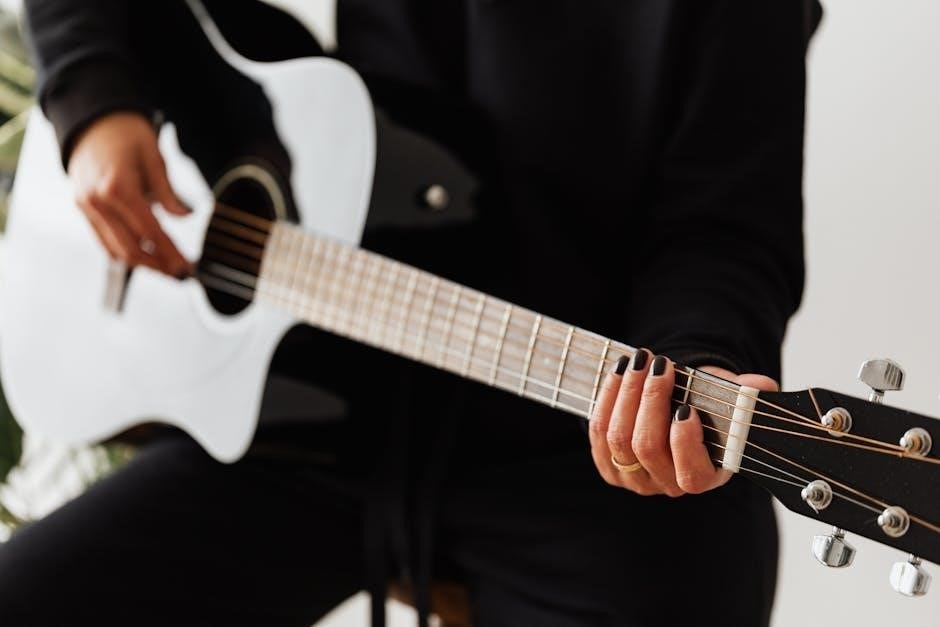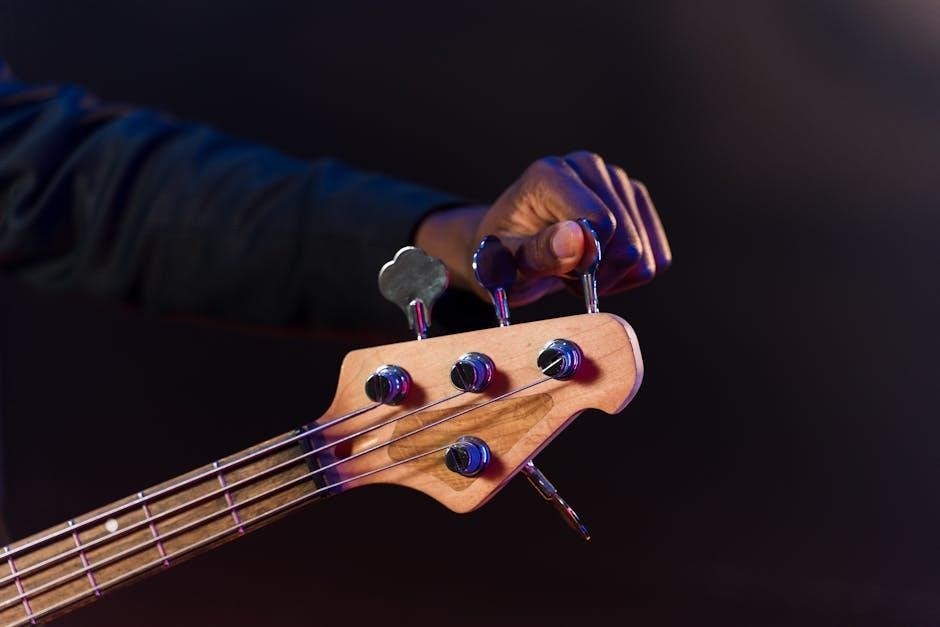Welcome to the world of bass guitar! This guide helps beginners master the basics, from understanding the instrument to playing techniques. Start your musical journey today!
1.1 Understanding the Basics of Bass Guitar
The bass guitar is a four-stringed instrument played with either a pick or fingers. Each string has a specific name (E, A, D, G) and number (1 to 4). Comfort and proper positioning are key for beginners. Learning the notes on the fretboard is essential, and resources like PDF charts can aid memorization. Understanding basic techniques, such as plucking and timing, will help you start playing. Begin with simple exercises and gradually explore more complex sounds as you gain confidence.
1.2 Importance of Learning Bass Guitar
Learning bass guitar enhances your musical understanding and rhythm. It teaches you to play in sync with others, making you a versatile musician. Mastering the bass boosts confidence and creativity, allowing you to contribute to various music styles; Resources like PDF guides and video lessons provide structured learning, ensuring you grasp techniques and theory effectively. Start your journey today and discover the joy of playing bass guitar!
1.3 Setting Up Your Bass Guitar
Setting up your bass guitar ensures comfort and ease of play. Adjust the bridge and action for smooth string vibration and proper height. Tune your bass accurately using a tuner or by ear; Choose the right strings and amp settings to suit your style. A well-set-up bass improves sound quality and playability. Use a PDF guide or consult a professional to ensure your bass is ready for optimal performance. Proper setup is key to enjoying your musical journey.

Parts of the Bass Guitar
The bass guitar features a body, neck, fretboard, and four strings. Key components include the bridge, tuning pegs, and pickups, essential for sound production and tuning.
2.1 Anatomy of the Bass Guitar
The bass guitar consists of a body, neck, and fretboard. It typically has four strings, with the bridge securing them at the body. The tuning pegs at the headstock adjust string pitch, while pickups capture vibrations for amplification. The fretboard is divided into frets, guiding note placement. Understanding these parts is crucial for proper setup and playability, ensuring comfort and sound quality. This basic anatomy forms the foundation of the instrument, essential for all techniques and styles.
2.2 String Names and Numbers
A standard bass guitar has four strings, named E, A, D, G, from lowest to highest pitch. These strings are numbered as 1 (E), 2 (A), 3 (D), and 4 (G). Knowing both the names and numbers helps in understanding tablature and playing techniques. Proper identification of strings is essential for tuning, fingering, and overall musicianship. This foundational knowledge ensures clarity when learning chords, scales, and arpeggios, making it easier to navigate the fretboard and execute various playing styles effectively.
2.3 Tuning Your Bass Guitar
Tuning your bass guitar is crucial for accurate sound production. The standard tuning is E, A, D, G, from lowest to highest pitch. Use a tuner or reference notes to achieve precision. Begin with the open E string, ensuring it matches the tuner’s display. Next, tune the A, D, and G strings sequentially. Proper tuning ensures your bass sounds clear and harmonious, allowing you to play effectively in any musical context. Regular tuning is essential for maintaining the instrument’s integrity and delivering quality performances consistently.

Holding and Playing the Bass Guitar
Proper posture and hand positioning are essential for comfortable playing. Hold the bass securely, with hands positioned for optimal access to strings and fretboard.
3.1 Proper Posture and Hand Positioning
Proper posture and hand positioning are crucial for comfortable and effective bass playing. Stand or sit upright, with the bass held securely at a slight angle. The neck should be parallel to the ground, and the body should rest comfortably against you. Your left hand should support the neck gently, with fingers close to the fretboard. The right hand should be positioned near the bridge, with fingers or a pick ready to pluck strings. Avoid slouching or straining, as this can lead to fatigue and discomfort. Practice holding the bass correctly to ensure proper technique and avoid long-term discomfort.
3.2 Holding the Pick vs. Fingerstyle Techniques

Holding the pick or using fingerstyle techniques are two primary methods for playing the bass. A pick provides a bright, aggressive sound, while fingerstyle offers a dynamic, organic feel. For pick playing, hold it firmly between your thumb and index finger, striking strings with a smooth motion. Fingerstyle involves plucking strings with your index and middle fingers, allowing for nuanced expression. Experiment with both to discover what suits your style and musical goals. Both techniques are versatile and widely used in various genres.
3.3 Basic Plucking Techniques
Mastering basic plucking techniques is essential for every bassist. Start with the index and middle fingers, plucking the strings with the pads of your fingers. Keep your wrist relaxed and use your forearm for motion. Focus on consistency and accuracy, ensuring each note rings clear. Begin with open strings, then progress to fretted notes. Practice alternating between fingers to build rhythm and coordination. These foundational techniques will enhance your overall playing and provide a solid base for more advanced styles, such as slapping and popping. Regular practice will improve your tone and control.

Learning the Notes on the Fretboard
Mastering the fretboard is crucial for bassists. Use a PDF chart to identify notes, understand their positions, and build confidence in your playing. Start with open strings and progress to fretted notes, ensuring clarity and accuracy with each pluck. Regular practice will enhance your tone and control, providing a solid foundation for more advanced techniques like slapping and popping. This section will guide you through the essentials of note identification and memorization.
4.1 Understanding the Fretboard Layout
The bass guitar fretboard is a grid of strings and frets. Each string corresponds to a specific note, with frets dividing the string into segments. The layout is repeating, with notes arranged in a pattern. Understanding this layout is essential for navigation. A PDF fretboard chart is a valuable tool, providing a visual guide to note positions. Start by identifying open strings and their notes. Gradually explore fretted notes, noting how each fret changes the pitch. Memorize the pattern to build familiarity and improve playing efficiency. Practice regularly to enhance your understanding and confidence.
4.2 Memorizing Notes with a PDF Fretboard Chart
A PDF fretboard chart is an excellent resource for memorizing bass guitar notes. It visually maps each string’s notes across the frets, making learning straightforward. Start by labeling the open strings (E, A, D, G). Then, focus on one string at a time, associating each fret with its corresponding note. Use flashcards or write notes on the chart to reinforce memory. Regular practice and repetition will help solidify your understanding. Over time, this will become second nature, enhancing your playing skills and confidence. Consistency is key to mastery.
4.3 Tips and Tricks for Memorization
Memorizing bass guitar notes can be made easier with strategic techniques. Break the fretboard into smaller sections and focus on one area at a time. Use mnemonics or patterns to associate notes with shapes or sounds. Practice scales and arpeggios regularly to build muscle memory. Repetition is key—spend time daily reviewing notes. Incorporate games or flashcards to make learning engaging. Finally, apply your knowledge by playing simple songs, reinforcing note recognition in a practical context. Consistency and creativity will accelerate your progress.
Basic Music Theory for Bass Guitar
Mastering root notes, rhythm, and timing is essential for bassists. Learn scales and arpeggios to build a strong musical foundation, enhancing your playing and creativity.
5.1 Root Notes and Their Importance
Root notes are the foundation of chords and scales, defining the harmonic structure of music. For bassists, they provide the rhythmic and melodic backbone, ensuring alignment with chord progressions. Learning root notes enhances timing and rhythm, essential for syncing with other musicians. They guide the bassist in creating supportive lines that complement the melody. Understanding root notes is vital for beginners, as they form the basis of musical communication and coordination within a band. Mastering them unlocks creativity and solidifies your role as a bass player.
5.2 Understanding Rhythm and Timing
Rhythm and timing are fundamental to playing the bass guitar effectively. They dictate how notes are played in relation to time, ensuring a steady groove. Mastering rhythm involves understanding time signatures, tempos, and syncopation. Practicing with a metronome helps develop accuracy. Timing also affects the feel of the music, making it essential for syncing with drummers and other musicians. Strong rhythmic skills enhance overall musicality, allowing bassists to create dynamic, engaging performances. Regular practice with backing tracks and exercises can refine these skills.
5.3 Basic Scales and Arpeggios
Mastering basic scales and arpeggios is crucial for bass guitarists. Scales provide the foundation for melodies and solos, while arpeggios break down chords into individual notes. Start with major and minor scales, focusing on proper fingering and technique. Arpeggios help develop finger independence and improve note accuracy. Regular practice with exercises and backing tracks enhances muscle memory and musicality. These skills are essential for creating smooth transitions and dynamic basslines, making them a cornerstone of every bassist’s practice routine.

Practicing Techniques
Master right-hand techniques, practice with backing tracks, and use progressive exercises to build skills. Regular practice improves timing, rhythm, and overall bass-playing proficiency for beginners.
6.1 Developing Right-Hand Techniques
Mastering right-hand techniques is crucial for bass guitar beginners. Start with basic plucking using fingers or a pick. Focus on consistency and rhythm. Practice arpeggios and scales to improve dexterity. Use exercises like chromatic scales to build finger independence. Timing is key—play along with metronomes or backing tracks. Gradually increase speed and complexity as you gain confidence. Regular practice strengthens your right-hand muscles, enhancing overall performance. Dedicate time daily to refine these techniques for a solid foundation.
6.2 Practicing with Backing Tracks
Backing tracks are an excellent way to enhance your bass guitar practice. They provide a realistic musical context, helping you develop timing and rhythm. Start with slow tempos and gradually increase speed as you gain confidence. Use free resources like downloadable PDFs or online platforms that offer backing tracks specifically for bass guitar. Focus on playing along with the tracks, emphasizing groove and consistency. This method allows you to apply learned techniques in a dynamic setting, making practice engaging and productive while improving your overall musicianship.
6.3 Progressive Exercises for Beginners
Progressive exercises are designed to help beginners build technique and confidence gradually. Start with simple scales and arpeggios, then move to more complex patterns. Use downloadable PDF resources for structured lessons. Practice chromatic exercises to improve finger dexterity and accuracy. Begin with slow tempos and increase speed as you progress. Incorporate these exercises into your daily routine, focusing on proper fingering and timing. This step-by-step approach ensures steady improvement and mastery of essential bass guitar skills.

Advanced Techniques for Beginners
Explore advanced techniques like slapping and popping, discover how to play chords and arpeggios, and improve note lengths and dynamics for a polished sound.
Slapping and popping are dynamic techniques that add percussive effects to your bass playing. Slapping involves striking the strings with your thumb, creating a sharp, crisp sound. Popping uses your index and middle fingers to pluck the strings, producing a bouncy rhythm. These techniques require precise finger placement and timing. Start with slow exercises to build control, then gradually increase your speed. Practice with backing tracks to enhance your groove and timing. These methods will elevate your bass lines and add a professional touch to your music.

7.2 Playing Chords and Arpeggios
Playing chords and arpeggios on the bass adds depth and complexity to your music. Start with simple major and minor chords, focusing on clean, precise notes. Arpeggios involve playing chord notes in sequence, creating a melodic flow. Practice arpeggios slowly, ensuring smooth transitions between notes. Use a metronome to improve timing. Begin with common chords like C, G, and Am. Gradually incorporate more complex chord structures as you gain confidence. These techniques will enhance your versatility and allow you to contribute rich, harmonic lines to your music.
7.3 Improving Note Lengths and Dynamics
Mastering note lengths and dynamics enhances your bass playing expressiveness. Practice varying note durations to add depth to your lines. Focus on playing legato for smooth, connected notes and staccato for shorter, sharper tones. Dynamics involve playing softly (piano) or loudly (forte). Use your right hand to control volume and attack. Experiment with phrasing exercises to develop control over sustain and decay. Incorporate these techniques into scales and arpeggios for a polished, professional sound. Regular practice will refine your ability to convey emotion through your playing.

Resources for Learning Bass Guitar
Explore free PDFs, video lessons, and online courses to enhance your learning. Utilize fretboard charts, theory guides, and backing tracks for comprehensive practice and skill improvement.
8.1 Free PDF Resources and Worksheets
Discover a wealth of free PDF resources designed to help beginners master the bass guitar. Download fretboard charts, rhythm worksheets, and exercises to improve technique. These materials often include tips for memorizing notes, understanding scales, and enhancing timing. Many resources are structured to complement online lessons or in-person instruction, offering additional practice exercises and theory explanations. Printable PDFs are ideal for quick reference, ensuring you can practice anywhere, anytime, and track your progress effectively.
8.2 Recommended Video Lessons and Tutorials
Enhance your learning with recommended video lessons and tutorials. YouTube channels like Dan Hawkins offer exceptional instruction for all skill levels. Platforms such as eBassGuitar.com provide comprehensive lessons, covering techniques, theory, and practical exercises. Many tutorials include backing tracks and full-band audio, helping you apply your skills in real musical contexts. These resources are ideal for supplementing your practice, ensuring a well-rounded understanding of bass guitar playing. Start your journey with these expert-guided videos and elevate your musical abilities today!
8.3 Online Courses and Communities
Online courses and communities offer invaluable support for bass guitar learners. Platforms like TrueFire and ArtistWorks provide structured lessons tailored for beginners. Websites such as TalkBass and bass-specific Facebook groups foster engagement and feedback. These resources connect you with fellow learners and experienced players, creating a motivating environment. Online forums also share tips, challenges, and inspiration, helping you stay committed to your musical growth. Join these communities to enhance your learning experience and gain confidence in your abilities. Embrace the power of shared knowledge and collaborative learning today!

Setting Goals and Tracking Progress
Setting achievable goals helps track your bass guitar journey. Create a practice schedule, define musical objectives, and celebrate milestones. Regularly assess your improvement to stay motivated and focused. Track progress to ensure steady growth and enjoy the rewarding process of mastering the bass guitar.
9.1 Creating a Practice Schedule
Establishing a consistent practice schedule is key to mastering the bass guitar. Allocate specific times daily for technique exercises, note memorization, and playing along with backing tracks. Prioritize goal-oriented sessions, ensuring each practice addresses different skills. Set realistic time frames to avoid burnout. Regularity and structure will accelerate your progress. Use a planner or app to track sessions and maintain accountability. Consistency is essential for steady improvement and achieving your musical goals.
9.2 Setting Achievable Musical Goals
Setting clear, achievable goals is crucial for steady progress. Break down your objectives into short-term and long-term targets. For example, start with learning the notes on the fretboard, then progress to playing simple songs. Celebrate milestones to stay motivated. Focus on technique, theory, and repertoire. Align your goals with your musical interests to keep learning enjoyable. Regularly review and adjust your targets to ensure they remain relevant and challenging. This structured approach will help you stay focused and inspired throughout your journey. Consistency is key to success.
9.3 Tracking Your Improvement
Tracking your progress is essential to staying motivated and understanding your growth. Use tools like practice journals or apps to log your sessions and note improvements. Record yourself playing regularly to hear your development over time. Celebrate small milestones, such as mastering a difficult riff or improving timing. Regularly review your goals and adjust them as needed. Seeing your progress will inspire you to continue learning and refining your skills. Consistent tracking helps maintain focus and ensures steady improvement.
